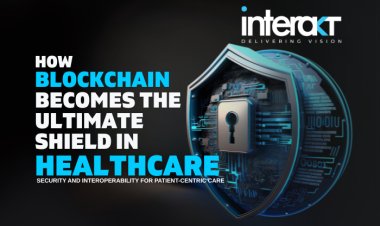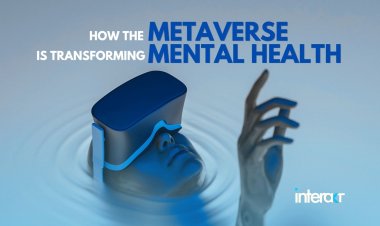How 2025’s Cyberattacks Are Exposing the Cost of Unsecured Transformation
From ransomware paralysing global supply chains to AI-enabled phishing campaigns, 2025 has redefined cybersecurity as the foundation of digital transformation. Discover key global attack trends, in-depth case studies and the Interakt Techsol blueprint for cyber-resilience across AI, IoT, Blockchain and Cloud ecosystems.

Digital transformation has powered innovation, but also exposed new fault lines. As enterprises adopt AI, IoT, blockchain, and cloud native architectures, the attack surface expands dramatically. According to one recent analysis, 16% of reported cyber-incidents in 2025 involved attackers leveraging AI tools such as generative image or language models to amplify social engineering.
In 2025, cyberattacks cost global businesses over US $12 trillion, with AI-generated phishing and supply-chain intrusions rising at record speed.
- Ransomware losses: US $38 billion (Cybersecurity Ventures, 2025). Global ransomware damages are projected in the tens of billions for 2025
- Average breach cost: US $4.45 million (global average, IBM Cost of Breach Report 2025)
- AI-enabled attacks: +220 % year-over-year growth
- IoT vulnerabilities: One in four enterprises suffered a device-level intrusion
- Supply-chain breaches account for roughly 30% of all recorded incidents, up from much lower previously.
- Cloud misconfiguration and credential abuse remain dominant vectors.
As Interakt Techsol helps enterprises integrate AI, Blockchain, IoT and Cloud, our message is clear: Transformation without Cyber Defense is Digital Exposure, this means cybersecurity isn’t a layer, it’s the bedrock of transformation.
The Threat Landscape: What’s Changing
2.1 AI-Powered Attacks
Attackers are using generative AI to craft more convincing phishing, bypass detection filters, automate reconnaissance, and adapt attacks in real-time. As noted above: 16% incidence rate.
2.2 Ransomware-as-a-Service (RaaS) & Double-Extortion
Groups now offer ransomware kits, affiliate programs, and profit-sharing. Downtime averages 24 days or more.
This isn’t just data theft, it’s operational paralysis.
2.3 IoT & Smart Device Vulnerabilities
With billions of connected devices (industrial sensors, wearables, smart grid nodes), each becomes a potential entry point. A single compromised IoT node can cascade into a major disruption.
2.4 Supply Chain & Third-Party Risk
A vendor’s breach can hit you. For example, third-party breaches are now estimated to represent ~30% of incidents.
2.5 Credential-Based & Insider Threats
Hybrid work, remote access and legacy identity systems make credentials the easiest target. “Stolen credentials” remain among top breach causes.
Real-World Case Studies
Case Study #1 – Automotive Manufacturing: Jaguar Land Rover Cyberattack (U.K. / Global, 2025) – When Supply Chains Collapse
Date: August–September 2025
Scale: £1.9 billion loss to the U.K. economy (~US $2.5 billion)
Attackers: Suspected ransomware collective (under investigation)
What happened
In late August 2025, Jaguar Land Rover (JLR), one of the world’s largest automotive manufacturers, experienced a catastrophic cyberattack that disrupted production across multiple plants in the U.K., Slovakia, India, and China.
The intrusion originated via a compromised third-party supplier, allowing ransomware to propagate through connected manufacturing and logistics networks.
Digital assembly systems, vendor dashboards, and internal ERP platforms were encrypted within hours, halting operations company-wide.
Consequences & Fallout
- Manufacturing freeze: Production stopped for nearly two weeks, impacting ~5,000 tier-1 and tier-2 suppliers.
- Economic ripple: Estimated loss to U.K. GDP at £1.9 billion, making it the nation’s most expensive industrial cyberattack.
- Reputational damage: JLR faced stakeholder backlash over weak supplier controls.
- Operational chaos: Supply chains spanning 17 countries were temporarily paralyzed, delaying vehicle shipments globally.
- Employment impact: Thousands of temporary layoffs during downtime.
Lessons Learned
- Supply-chain transparency is mission-critical: Cyber defense must extend to every connected vendor.
- Segmentation of OT/IT networks: Isolating production systems from corporate IT prevents attack propagation.
- Digital twins need digital shields: IoT and automation require built-in monitoring and redundancy.
- Business resilience = national resilience: For critical industries, cyberattacks carry geopolitical and economic consequences.
Case Study #2: Snowflake Data Breach (Global, 2024–2025) – Cloud Data Platform Attack
Date: December 2024 – May 2025
Scale: 160+ organizations compromised; billions of customer records leaked
Attackers: UNC5537 threat group (linked to data exfiltration marketplaces)
What happened
Between late 2024 and mid-2025, threat actors exploited misconfigured Snowflake cloud environments lacking enforced MFA and API rate-limiting controls.
Attackers used credential stuffing attacks with previously leaked passwords to gain access to Snowflake tenants used by global corporations, including banks, e-commerce platforms, and healthcare firms.
Once inside, they exfiltrated terabytes of sensitive data including names, contact information, purchase histories, and authentication tokens, selling them on dark web forums.
Consequences & Fallout
- Data exposure: Billions of personal and enterprise records compromised.
- High-value targets: Included companies in finance, telecom, and energy sectors.
- Regulatory scrutiny: Several affected firms faced GDPR and APPI inquiries in Europe and Japan.
- Business trust impact: Enterprises relying on Snowflake reevaluated vendor risk management policies.
Lessons Learned
- Shared responsibility in cloud security: Providers ensure infrastructure; clients must secure identity and access.
- Credential rotation & MFA are mandatory: Cloud admin accounts remain top breach vectors.
- Continuous monitoring: Cloud workloads need automated anomaly detection and geo-fencing.
- Encryption in use: Protecting data at rest and in transit is not enough runtime encryption is emerging as best practice.
Case Study #3: Change Healthcare / UnitedHealth Breach (U.S., 2024–2025) - The Largest in U.S. History
Date: February 2024
Scale: ~190 million patients affected
Attackers: ALPHV / BlackCat ransomware group
What happened
In February 2024, a ransomware affiliate (often attributed to the ALPHV / BlackCat group) infiltrated Change Healthcare, a subsidiary of UnitedHealth. The attackers gained access via compromised credentials in a remote access (Citrix) portal, where multi-factor authentication (MFA) was not enforced.
Over a period of days, they exfiltrated protected health information (PHI) for ~190 million U.S. individuals, making this the largest healthcare breach on record.
On February 21, 2024, the attackers triggered ransomware encryption across Change Healthcare’s infrastructure, impacting its ability to process claims, verify patient eligibility, and route billing/insurance data.
Consequences & Fallout
- Hospitals and providers nationwide had to switch to manual, paper-based workflows for billing, claims, and patient registration.
- Change in the first three weeks saw ~$6.3 billion in lost claim value across 1,850 hospital clients and 250,000 physician clients.
- UnitedHealth reported an $872 million loss in Q1 2024 alone, and annualized losses reached $3.09 billion.
- Some services were still partially unavailable months later. Change Healthcare’s service restoration took until November 2024 in many parts.
- From a safety perspective: delays in care authorization, disruption to prescription processing, billing chaos and downstream resource strain on hospital operations.
Lessons Learned
- Third-party risk is existential. The attack was not directly on a hospital, but on its service provider. Once attackers compromised that “hub,” many “spoke” hospitals were impacted.
- MFA and zero trust are non-negotiable. This breach likely would have been prevented or greatly limited had MFA been enforced on the remote access portal.
- Incident response and resilience matter. Hospitals should plan for worst-case extended outages and ensure alternate workflows, redundancy, and backup systems.
- Transparency & communication with patients, clients, regulators is critical, delays in disclosure erode trust further.
Case Study #4: Government Infrastructure: St. Paul (City of, Minnesota, US, 2025) – When Public Infrastructure Goes Dark
Date: July 2025
Scale: Citywide systems disrupted; 43 GB of stolen data published online
Attackers: Ransomware group “Medusa” (claimed responsibility)
What happened
On July 25, 2025, the City of St. Paul, Minnesota declared a state of emergency following a coordinated ransomware attack that disabled municipal networks, payment systems, and online services.
Attackers gained entry through an unpatched vulnerability in a third-party remote management tool used by the city’s IT vendor.
Within hours, vital systems utility billing, permit processing, and staff communication were encrypted. The Medusa group demanded a multimillion-dollar ransom in cryptocurrency, which officials refused to pay.
Consequences & Fallout
- Operational disruption: Online services halted for several weeks.
- Data leak: Attackers released 43 GB of citizen and employee data, including payroll and internal correspondence.
- Emergency response: Minnesota National Guard cyber units deployed for containment.
- Public trust impact: Residents experienced major service delays; local agencies faced reputational damage.
Lessons Learned
- Public-sector digitalization needs enterprise-grade security: Municipal systems are no longer “low-interest” targets.
- Patch management and vendor oversight: Vulnerable third-party tools are frequent attack vectors.
- Cyber response readiness: Rapid coordination between local IT, state, and national cyber units is essential.
- Incident transparency: Quick disclosure prevented misinformation and panic.
Case Study #5: Qantas Airways Data Breach (Australia, 2025) – The Loyalty Leak
Date: July 2025
Scale: Up to 6 million customer records exposed
Attackers: “IntelBroker” cyber extortion group
What happened
In July 2025, Qantas Airways, Australia’s flagship carrier, confirmed a data breach involving up to six million customers.
The attack originated through a third-party vendor managing customer loyalty and booking platforms, which stored unencrypted datasets.
Attackers accessed names, birthdates, frequent-flyer IDs, and email addresses—though financial and passport data were reportedly unaffected.
Within days, samples of the data appeared on leak sites as proof-of-compromise.
Consequences & Fallout
- Data privacy breach: PII exposed, risking phishing and identity theft.
- Regulatory action: Australian Cyber Security Centre (ACSC) and OAIC launched investigations.
- Brand damage: Erosion of consumer trust across loyalty and travel programs.
- Legal exposure: Class-action lawsuits initiated by affected users.
Lessons Learned
- Third-party governance is essential: Vendors handling customer data must meet equivalent security standards.
- Data minimization: Limit PII storage—especially in external systems.
- Encryption and tokenization: Sensitive data should never exist unencrypted in operational environments.
- Proactive communication: Qantas’ early disclosure limited long-term brand damage.
Case Study #6: DaVita Ransomware Attack- When Dialysis Centers Went Dark
Date: April 2025
Type: Ransomware + network encryption
Impact: Service disruption across multiple dialysis centers
In April 2025, DaVita, one of the world’s largest kidney care providers, reported a ransomware attack that forced multiple centers into partial shutdown.
- Attackers encrypted internal systems, lab records, and scheduling servers.
- Some clinics switched to emergency “offline” treatment mode; others diverted patients to nearby facilities.
- DaVita confirmed the involvement of law enforcement and cyber-forensic experts.
Patient impact:
Dialysis - a life-sustaining treatment - runs on a precise schedule. Even a 24-hour delay can lead to severe metabolic complications.
A DaVita patient told Reuters:
“It wasn’t just a data problem — I was scared my treatment would be skipped. That’s my life.”
Lesson: Every cyberattack is a clinical incident. Downtime translates into physiological risk.
Case Study #7: Synnovis / NHS London (UK, 2024) — When a Lab Breach Stops Surgeries
Date: June 2024
Region: United Kingdom
Attackers: Qilin ransomware group
Though not a hospital per se, this case shows how lab services or diagnostic support systems can be leveraged to cripple hospital operations — with direct patient safety impact.
What happened
- In June 2024, Synnovis, a lab service partner for multiple NHS trusts in London, was attacked via ransomware (claimed by the Qilin group) and exfiltration of ~400 GB of data.
- The attack forced hospitals including Guy’s, St Thomas’, King’s College, Royal Brompton, Evelina Children’s Hospital, and others to declare a clinical “critical incident”.
- Services such as blood testing, pathology, and lab reports were disrupted. Some scheduled surgeries and blood transfusions had to be postponed or routed to alternate facilities. At least 1,600 surgeries and hundreds of appointments were postponed.
- Because automated safety checks and lab result pipelines were unavailable, hospitals had to revert to manual, paper protocols, increasing risk of error.
Consequences & Costs
- Estimated cost of the attack: ~£32.7 million, far exceeding Synnovis’ 2023 profit of £4.3 million.
- Reputational damage, regulatory scrutiny, and investigation by the UK Information Commissioner’s Office.
- Clinical safety concerns: delays in diagnostics, transfusions, surgery scheduling — all posing potential patient harm.
Lessons Learned
- Supply chain / partner risk again: Disruption to an essential diagnostic service cascaded into multiple hospitals.
- Segmentation & isolation: Lab systems should be logically separated from core hospital networks; compromise in one should not propagate.
- Fallback protocols and redundancy: Hospitals should simulate manual lab operations and prepare for extended outages.
- Rapid incident containment is essential — once the breach is detected, isolating parts of the network is critical.
Case Study #8: American Hospital Dubai, UAE (2025) - The Middle East’s Largest Healthcare Data Leak
Date: June 2025
Attackers: Gunra ransomware group
Impact: ~450 million records (~4TB) compromised
This is a more recent high-impact case in the Middle East, especially relevant for the UAE’s growing digital health footprint.
What is publicly known
- In 2025, Gunra ransomware gang claimed to have stolen and encrypted 450 million patient records (≈ 4 TB) from American Hospital Dubai.
- It forced the hospital’s network into isolation. Clinicians resorted to “downtime mode” — relying on manual recordkeeping and paper charts.
- The breach prompted alarm in regional healthcare security circles, as such a scale of data loss in a regionally prominent hospital had not been seen.
- Separately in Dubai, NHS Moorfields Hospital also confirmed a ransomware breach, with ~60 GB of internal data copied or encrypted, claimed by AvosLocker.
Implications & Speculated Impact
- From oncology to maternity, multiple departments faced delays as clinicians re-entered data manually.
- Massive data exposure risk: PHI, imaging, diagnoses, billing, patient identifiers.
- Legal, regulatory risks in UAE’s evolving data protection and health regulatory environment.
- Patient trust erosion: IF data leaks become public, patients may avoid digital services or withhold information.
Lessons & Warnings
- Even in digitally advanced health systems, scale of attack can overwhelm defenses.
- Data encryption + exfiltration (double extortion) is now standard in high-value targets.
- Proactive security posture is essential: threat detection, segmentation, active monitoring, and rapid isolation.
- Regional context matters: regulatory enforcement, cross-border threat actors, and geopolitical risk.
Regional Perspective 2025
Key Takeaways & Strategic Cyber-Defense Framework
From the above case studies, some consistent patterns and insights emerge. For the Interakt Techsol audience, here’s a structured defense framework:
When Breaches Become Business Earthquakes
The five cyberattacks you just read about didn’t only cripple networks, they halted supply chains, froze cities, delayed treatments, and shattered trust.
Cyber incidents are no longer confined to IT rooms.
They ripple through factories, hospitals, classrooms, and homes.
Every encrypted server means an idle production line.
Every stolen credential means a disrupted delivery chain.
Every leaked record means a lost customer—and a lost heartbeat of trust.
This is not a technology issue anymore.
It’s an economic, ethical, and existential one.
Why This Matters for Interakt Techsol Clients
- Cross-Vertical Relevance: Whether in agritech (IoT sensors + blockchain traceability), fintech (cloud data + AI risk modelling) or health-tech (wearables + patient data), the cyber-risk is real, broad and evolving.
- Transformation Risk = Cyber Risk: Digitalization drives growth; but also risk. The same ecosystems that enable AI, IoT & blockchain also expand attack surfaces.
- Global & Regional Complexity: With operations spanning Japan, India, UAE, US, Europe etc., geo-specific regulations, threat profiles and vendor ecosystems differ, your cyber strategy must be global, yet locally tuned.
- Brand & Trust at Stake: A breach is not just IT damage; it’s business, reputation, regulatory, operational and strategic damage. For companies positioning SAAS/AI/IoT/Blockchain solutions, trust is a primary commodity.
- Competitive Advantage: Organizations that build “security by design” at the core will differentiate themselves and attract partners, investors and clients accordingly.
In the era of AI, Blockchain, and IoT, data isn’t just information; it’s infrastructure.
When that infrastructure collapses, entire ecosystems collapse with it.
Ransomware isn’t just a digital crime, it’s a supply-chain blockade.
A misconfigured cloud isn’t just a technical error, it’s a breach of national trust.
An unpatched IoT sensor isn’t just a glitch, it’s an open door to global disruption.
The line between IT safety and operational continuity has vanished.
Cybersecurity is now the backbone of digital transformation.
At Interakt Techsol, we don’t just build digital systems, we build secure ecosystems. We believe cyber defense isn’t about reaction; it’s about design. From the first line of code to the last API handshake, every system we build carries a core principle:
“If it’s connected, it must be protected.”
Our work across AI, Blockchain, and IoT ecosystems is guided by a single vision; to make technology intelligent, interoperable, and invulnerable.
Because transformation without protection isn’t innovation; it’s exposure.
And progress without trust isn’t progress at all.
Our blockchain, AI, IoT and cloud solutions are architected with security as DNA:
- Zero Trust-enabled ERP and IoT platforms
- AI cyber intelligence integrated into enterprise apps
- Blockchain-based data integrity for finance and agriculture
- Secure cloud migration and monitoring frameworks
- End-to-end audit and compliance for multi-geo operations
“In a hyper-connected world, trust is the new currency. Cybersecurity isn’t just IT policy, it’s corporate strategy.”- Hema Dubey
Is your organization prepared for Cyber Defense 4.0?
Contact Interakt Techsol for Cybersecurity Consulting and discover how we can help build secure, compliant and future-ready digital ecosystems.
info@interakttechsol.com | www.interakttechsol.com












